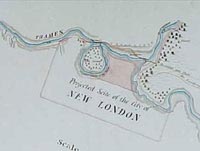 | Survey of the River La Tranche or Thames, c. 1795. Copy, National Map Collection, Public Archives of Canada
Lt.-Gov. Simcoe's route is marked in red.
|
Following a failed attempt by Upper Canada's first Lt.-Gov., John Graves Simcoe, to place the capital of the colony (created in 1791) there, the Forks of the Thames remained an undisturbed crown reserve until 1826. His name for the capital, 'New London', later just 'London', stuck.
Settlement slowly approached the Forks in the years leading up to 1826, as newly-arrived settlers from the U.S. and the British Isles were located in nearby townships by Col. Thomas Talbot, the area's highly independent land agent. By 1825, the size of the inland population warranted relocation of the district capital away from Vittoria, a village near Lake Erie, to the Forks.
Most settlers in the London District, after a season of land clearing, could put in a small crop of wheat, soon to be southwestern Ontario's major crop, extensively cultivated as late as the 1860s. Planted and harvested almost entirely with hand tools until the 1850s, wheat had a ready market in the US and Great Britain, bringing prosperity to the area's settlers.
During the War of 1812, two battles were fought to the west of the Forks. At the Battle of the Thames, October 5, 1813, near Moraviantown, approximately 3000 US militia defeated a British and native force of about 1000. It was during this battle that the great chief Tecumseh was killed. The British suffered a second defeat at the Battle of Longwoods in March of 1814. Following these losses raiding parties crossed the area several times burning mills and looting settlements.
|
 |
|